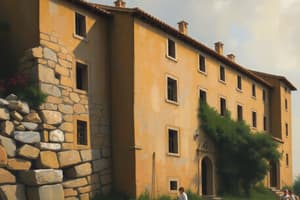Podcast
Questions and Answers
What property of stone is important when it is used for flooring, paving, and stair treads?
What property of stone is important when it is used for flooring, paving, and stair treads?
- Strength
- Workability
- Hardness (correct)
- Durability
Which rock type is formed by the crystallization of molten magma?
Which rock type is formed by the crystallization of molten magma?
- Marble
- Slate
- Granite (correct)
- Quartzite
What property is usually about 1/10 of a stone's compressive strength?
What property is usually about 1/10 of a stone's compressive strength?
- Workability
- Hardness
- Shear strength (correct)
- Durability
Which rock type has undergone a change in structure, texture, or composition due to natural agencies like heat and pressure?
Which rock type has undergone a change in structure, texture, or composition due to natural agencies like heat and pressure?
Which property affects a stone's ability to withstand frost action and staining?
Which property affects a stone's ability to withstand frost action and staining?
How is sedimentary rock formed?
How is sedimentary rock formed?
What is the main purpose of stone masonry in construction?
What is the main purpose of stone masonry in construction?
Which type of stone consists of rough fragments with at least one good face for exposure in a wall?
Which type of stone consists of rough fragments with at least one good face for exposure in a wall?
What is Argillite primarily used for in construction?
What is Argillite primarily used for in construction?
In stone construction, what is the purpose of panelling?
In stone construction, what is the purpose of panelling?
Which type of stone is known for its high strength, smooth structure, and low absorption?
Which type of stone is known for its high strength, smooth structure, and low absorption?
What does random ashlar stone masonry lack compared to coursed ashlar?
What does random ashlar stone masonry lack compared to coursed ashlar?
What stone finish is characterized by emphasized face-plane shifts and rough corners?
What stone finish is characterized by emphasized face-plane shifts and rough corners?
What type of stone finish is created by aligned blocks with a recessed cut margin forming a channel?
What type of stone finish is created by aligned blocks with a recessed cut margin forming a channel?
Which stone type is typically used for paving and may be rectangular or naturally rounded?
Which stone type is typically used for paving and may be rectangular or naturally rounded?
Flashcards
Hardness
Hardness
A property of stone important for flooring, paving, and stair treads.
Granite
Granite
A rock type formed by the crystallization of molten magma.
Shear strength
Shear strength
Usually about 1/10 of a stone's compressive strength.
Slate
Slate
Signup and view all the flashcards
Durability
Durability
Signup and view all the flashcards
Sedimentary rock formation
Sedimentary rock formation
Signup and view all the flashcards
Stone masonry purpose
Stone masonry purpose
Signup and view all the flashcards
Rubble
Rubble
Signup and view all the flashcards
Argillite usage
Argillite usage
Signup and view all the flashcards
Panelling purpose
Panelling purpose
Signup and view all the flashcards
Limestone
Limestone
Signup and view all the flashcards
Random ashlar stone masonry
Random ashlar stone masonry
Signup and view all the flashcards
Rock face finish
Rock face finish
Signup and view all the flashcards
Rusticated finish
Rusticated finish
Signup and view all the flashcards
Cobble stone
Cobble stone
Signup and view all the flashcards
Study Notes
Properties and Types of Stone
- Important properties for flooring, paving, and stair treads include durability, resistance to wear, and slip resistance.
- Igneous rock is formed by the crystallization of molten magma, resulting in a solidified structure.
- The tensile strength of stone is typically about 1/10 of its compressive strength, indicating its ability to resist bending.
- Metamorphic rock undergoes changes in structure, texture, or composition due to heat and pressure, altering its original form.
Stone Formation and Uses
- Sedimentary rock forms through the accumulation and compaction of mineral and organic particles over time, often in layers.
- The main purpose of stone masonry in construction is to provide structural stability and aesthetic appeal, using stone as a primary building material.
- Rubble stone consists of rough fragments, typically with at least one smooth, finished face, making it suitable for exposed walls.
Stone Types and Applications
- Argillite is primarily used in construction for items like tiles and bricks due to its fine texture and ability to be shaped.
- In stone construction, panelling serves to enhance the visual appeal of walls, providing decorative and protective surfaces.
Finishing Techniques and Characteristics
- High-strength stone, with a smooth structure and low absorption rate, is ideal for demanding applications such as flooring and countertops.
- Random ashlar stone masonry lacks the uniformity of coursed ashlar, leading to a more varied and natural appearance in walls.
- A rough stone finish emphasizes face-plane shifts and features rough corners, adding texture to the surface.
- Aligned block finishing involves blocks with recessed cut margins that form a channel, providing a sleek and organized appearance.
- Sandstone is typically used for paving and can be found in rectangular shapes or naturally rounded forms, suited for walkways and driveways.
Studying That Suits You
Use AI to generate personalized quizzes and flashcards to suit your learning preferences.




